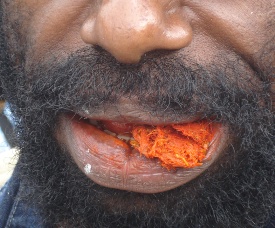 plenty of people with bright red teeth as well as the resulting red coloured streaks of spit along the ground. In Bahasa Indonesia it is known as “Makan Pinang”. The chewing of the Areca Palm nut is a 2500-year-old tradition in Malaysia and in the rest of South East Asia.
plenty of people with bright red teeth as well as the resulting red coloured streaks of spit along the ground. In Bahasa Indonesia it is known as “Makan Pinang”. The chewing of the Areca Palm nut is a 2500-year-old tradition in Malaysia and in the rest of South East Asia.
It is used by farmers and fishermen to alleviate the drudgery of repetitive work. It has a light hallucinatory effect.
Content:
1.Betel nut held in high regard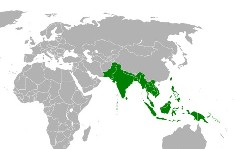
2.A packet of Pinang Ojek
3.Pinang chewing across age groups
4.Links to mouth and throat cancer
5.Links
6.Sources
1.Betel Nut held in high regard
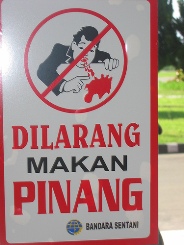 Papuans treasure the Betel Nut. Pinang is being chewed all over the place, in urban centres as well as in villages. Nearly every one is into it: Civil servants, students, and even health care workers. A mouth full of red teeth is something that distinguishes Papuans from non-Papuans. Papuans also chew the Areca Palm nuts during traditional ceremonies. The nuts are distributed to the guests as a sign of friendship and kinship. The nuts are cut into pieces and packaged in a leaf from the Betel Nut bush. Before chewing, the skin of the nuts are stripped off with the teeth and the fruit is then dipped into lime (a white powder). This is added to enhance the euphoric effect. The authorities are not that happy with this habit. In some places, such as at Sentani Airport, there are public signs saying ‘Forbidden to chew’ instead of ‘No smoking’.
Papuans treasure the Betel Nut. Pinang is being chewed all over the place, in urban centres as well as in villages. Nearly every one is into it: Civil servants, students, and even health care workers. A mouth full of red teeth is something that distinguishes Papuans from non-Papuans. Papuans also chew the Areca Palm nuts during traditional ceremonies. The nuts are distributed to the guests as a sign of friendship and kinship. The nuts are cut into pieces and packaged in a leaf from the Betel Nut bush. Before chewing, the skin of the nuts are stripped off with the teeth and the fruit is then dipped into lime (a white powder). This is added to enhance the euphoric effect. The authorities are not that happy with this habit. In some places, such as at Sentani Airport, there are public signs saying ‘Forbidden to chew’ instead of ‘No smoking’.
2.A packet of Pinang Ojek
After chewing the substance, it is spat out, leaving dried up red streaks on the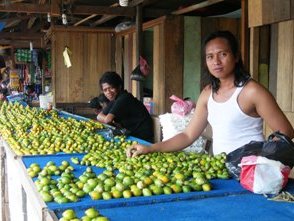 streets of Jayapura, Pinang vendors are out everywhere: on the markets and out on the sidewalks in front of shops.
streets of Jayapura, Pinang vendors are out everywhere: on the markets and out on the sidewalks in front of shops.
The Dani and coastal inhabitants from Biak, Sentani and Waropen do nothing all day but chew. This chewing is usually done in groups in Papua. For the Dani, it is not a substance that was traditionally used for rituals. For them it is a daily stimulant, addictive and relatively expensive. A packet of nuts (Pinang ojek) costs Rp 8000 to Rp10.000, depending on the size and quality of the product. It is mainly sold by women. If they invest some 60.000 Rp a day, they can make as much as Rp 120.000, which amounts to a profit of Rp1,8 million per month!
The Areca Palm grows well in the mountains but it did not used to grow there in the past. It has in fact become a new means of income.
3.Pinang chewing across age groups
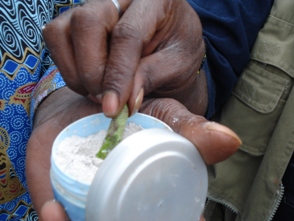 The betel nuts are devoured by the men, but you do regularly see women chewing this nut too.
The betel nuts are devoured by the men, but you do regularly see women chewing this nut too.The Betel nut or Areca Palm nut is chewed by at least 10% of the world population, but especially in Southeast Asia. It is estimated that up to 400 million people use it. The use of the Areca nut has a long history and it is anchored in many socio-cultural and religious activities. Specific strands, known for their bitter and sharp taste, are used in combination with tobacco and lime. The Missionaries in Former Dutch New Guinea tried to forbid chewing, but they never succeeded in this endeavour.
4.Link to mouth and throat cancer
Meanwhile, a definite link has been established between Pinang Chewing and mouth and throat cancer. Melanesia, Which includes Papua, has the highest number of cases of this type of cancer, counting some 267.000 in the year 2000, two thirds of these occur among men. The risk of getting oral cancer is much higher among individuals who smoke or chew betel nuts in combination with tobacco. Those who combine these two, have five times as high a chance of contracting oral cancer. In addition, it would seem that the lime during chewing contributes to the development of mouth cancer. According to a rapport published by the Bloomberg Family Foundation in 2007, male smokers of tobacco and Arececa live approximately 6 years shorter than the average, and among female smokers it takes as much as 8 years of their average life expectancy.
and throat cancer. Melanesia, Which includes Papua, has the highest number of cases of this type of cancer, counting some 267.000 in the year 2000, two thirds of these occur among men. The risk of getting oral cancer is much higher among individuals who smoke or chew betel nuts in combination with tobacco. Those who combine these two, have five times as high a chance of contracting oral cancer. In addition, it would seem that the lime during chewing contributes to the development of mouth cancer. According to a rapport published by the Bloomberg Family Foundation in 2007, male smokers of tobacco and Arececa live approximately 6 years shorter than the average, and among female smokers it takes as much as 8 years of their average life expectancy. 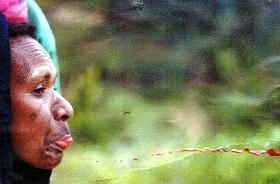 In the neighbouring country of Papua New Guinea (PNG), Governor Power Parkop wanted to eradicate the use of Betel nut on the streets of Port Moresby, its capital city, in 2009. “People here do not pay tax and we spend an enormous amount of money on cleaning up the mess caused by Betel nut users”, he declared. The Pinang chewing habit forms a real health risk for the community. Statistics put out by WHO indicate that at least 20% of the population suffers from oral cancer. According to Parkop, Betel nut use also leads to the spread of tuberculosis, one of the main causes of death in PNG. In Pakistan, where Betel nut chewing also occurs, it is compulsory to put health warnings on the Pinang packages, comparable to those on cigarette packages in the west.
In the neighbouring country of Papua New Guinea (PNG), Governor Power Parkop wanted to eradicate the use of Betel nut on the streets of Port Moresby, its capital city, in 2009. “People here do not pay tax and we spend an enormous amount of money on cleaning up the mess caused by Betel nut users”, he declared. The Pinang chewing habit forms a real health risk for the community. Statistics put out by WHO indicate that at least 20% of the population suffers from oral cancer. According to Parkop, Betel nut use also leads to the spread of tuberculosis, one of the main causes of death in PNG. In Pakistan, where Betel nut chewing also occurs, it is compulsory to put health warnings on the Pinang packages, comparable to those on cigarette packages in the west.
5. Links:
- Wikihow.com:Chew Betel nut In Papua New Guinea
- Web log by Remco van der Plas
- West Papua: The struggle with Nature, Economy and Health
6.Sources
- Various publications about the prevention of illnesses linked to Betel nut use.
- Extra information and photos by doctor Remco van der Plas